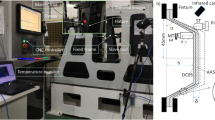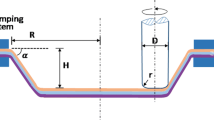Abstract
The widely investigated Al/steel laminated structures are challenged with subsequent plastic deformation due to the prone generation of interfacial brittle intermetallic compound layer. To overcome this drawback, a recently proposed thermomechanical forming technology as friction stir–assisted double-sided incremental plastic forming with synchronous solid-state interfacial bonding is utilized to fabricate Al/steel laminated structures. Typical interfacial bonding-forming performances produced by a series of experiments classified as sound bonding, de-bonding, over-thinning, penetration and crack are individually assessed. Local working peak temperature and maximum forming force in loading area are recorded and evaluated during stable bonding-forming stage. Considering the heat-force coupling effect, a pressure-strain-temperature–based prediction model is modified to assess interfacial quality, which is conformed to experimental results. This work can help obtain proper process window to successfully fabricate Al/steel laminated parts and shall also inspire to build guidance of related thermomechanical joining-with-forming processes to achieve high interfacial performance.









Similar content being viewed by others
References
Mori K, Bay N, Fratini L, Tekkaya AE (2013) Joining by plastic deformation. CIRP Ann 62(2):673–694. https://doi.org/10.1016/j.cirp.2013.05.004
Varis J (2006) Ensuring the integrity in clinching process. J Mater Process Technol 174(1–3):277–285. https://doi.org/10.1016/j.jmatprotec.2006.02.001
Groche P, Wohletz S, Brenneis M (2014) Joining by forming — a review on joint mechanisms, applications and future trends. J Mater Process Technol 214:1972–1994. https://doi.org/10.1016/j.jmatprotec.2013.12.022
Ling Z, Li Y, Luo Z, Feng Y, Wang Z (2016) Resistance element welding of 6061 aluminum alloy to uncoated 22mnmob boron steel. Mater Manuf Process 31(10):2174–2180. https://doi.org/10.1080/10426914.2016.1151044
Babu S, Panigrahi SK, Janaki GD (2019) Cold metal transfer welding of aluminium alloy AA2219 to austenitic stainless steel AISI 321. J Mater Process Technol 266:155–164. https://doi.org/10.1016/j.jmatprotec.2018.10.034
Edwards SP, Den AJ, Zhou J, Katgerman L (2009) Physical simulation of longitudinal weld seam formation during extrusion to produce hollow aluminum profiles. Mater Manuf Process 24(4):409–421. https://doi.org/10.1080/10426910802714290
Boccarusso L, Astarita A, Carlone P (2019) Dissimilar friction stir lap welding of AA 6082 - Mg AZ31: force analysis and microstructure evolution. J Manuf Process 44:376–388. https://doi.org/10.1016/j.jmapro.2019.06.022
Chung YD, Fujii H, Sun Y, Tanigawa H (2011) Interface microstructure evolution of dissimilar friction stir butt welded F82H steel and SUS304. Mater Sci Eng A 528(18):5812–5821. https://doi.org/10.1016/j.msea.2011.04.023
Sapanathan T, Jimenez-Mena N, Sabirov I (2019) A new physical simulation tool to predict the interface of dissimilar aluminum to steel welds performed by friction melt bonding. J Mater Sci Technol 35(09):2048–2057. https://doi.org/10.1016/j.jmst.2019.05.004
Reza-E-Rabby M, Ross K, Overman NR (2018) Joining thick section aluminum to steel with suppressed FeAl intermetallic formation via friction stir dovetailing. Scripta Mater 148:63–67. https://doi.org/10.1016/j.scriptamat.2018.01.026
Reza-E-Rabby M, Ross K, McDonnell M (2020) Numerical simulation and experimental validation of joint performance in aluminum-steel lap welds formed by friction stir dovetailing. J Mater Process Technol 277:116459. https://doi.org/10.1016/j.jmatprotec.2019.116459
Watanabe T, Takayama H, Yanagisawa A (2006) Joining of aluminum alloy to steel by friction stir welding. J Mater Process Technol 178(1–3):342–349. https://doi.org/10.1016/j.jmatprotec.2006.04.117
Wan L, Huang Y (2018) Friction stir welding of dissimilar aluminum alloys and steels: a review. Int J Adv Manuf Technol 99:1781–1811. https://doi.org/10.1007/s00170-018-2601-x
Tanaka T, Morishige T, Hirata T (2009) Comprehensive analysis of joint strength for dissimilar friction stir welds of mild steel to aluminum alloys. Scripta Mater 61(7):756–759. https://doi.org/10.1016/j.scriptamat.2009.06.022
Huang Z, Yanagimoto J (2015) Dissimilar joining of aluminum alloy and stainless steel thin sheets by thermally assisted plastic deformation. J Mater Process Technol 225:393–404. https://doi.org/10.1016/j.jmatprotec.2015.06.023
Li M, Wu RH, Cai S, Chen J (2020) Experimental investigation on friction-stir-assisted incremental forming with synchronous bonding of aluminum alloy and steel sheets. J Mater Eng Perform 29(2):750–759. https://doi.org/10.1007/s11665-020-04600-8
Govindaraj NV, Lauvdal S, Holmedal B (2013) Tensile bond strength of cold roll bonded aluminium sheets. J Mater Process Technol 213(6):955–960. https://doi.org/10.1016/j.jmatprotec.2013.01.007
Donati L, Tomesani L (2004) The prediction of seam welds quality in aluminum extrusion. J Mater Process Technol 153–154(22):366–373. https://doi.org/10.1016/j.jmatprotec.2004.04.215
Mahto RP, Kumar R, Pal SK, Panda SK (2018) A comprehensive study on force, temperature, mechanical properties and micro-structural characterizations in friction stir lap welding of dissimilar materials (AA6061-T6 & AISI304). J Manuf Process 31:624–639
Liu X, Lan S, Ni J (2014) Analysis of process parameters effects on friction stir welding of dissimilar aluminum alloy to advanced high strength steel. Mater Des 59:50–62
Wu RH, Liu XM, Li M, Chen J (2021) Investigations on deformation mechanism of double-sided incremental sheet forming with synchronous thermomechanical steel-aluminum alloy bonding. J Mater Process Technol 294:117147. https://doi.org/10.1016/j.jmatprotec.2021.117147
Praveen K, Lingam R, Reddy NV (2020) Tool path design system to enhance accuracy during double sided incremental forming: an analytical model to predict compensations for small/large components. J Manuf Process 58:510–523. https://doi.org/10.1016/j.jmapro.2020.08.014
Ai S, Dai R, Long H (2020) Investigating formability enhancement in double side incremental forming by developing a new test method of tension under cyclic bending and compression. J Mater Process Technol 275:116349. https://doi.org/10.1016/j.jmatprotec.2019.116349
Lu B, Fang Y, Xu DK, Chen J (2015) Investigation of material deformation mechanism in double side incremental sheet forming. Int J Mach Tools Manuf 93:37–48. https://doi.org/10.1016/j.ijmachtools.2015.03.007
Moser N, Zhang Z, Ren H, Zhang H, Shi Y, Ndip-Agbor EE, Cao J (2016) Effective strategy for double-sided incremental forming considering in-plane curvature and tool direction. CIRP Ann 65:265–268. https://doi.org/10.1016/j.cirp.2016.04.131
Ai S, Lu B, Chen J, Long H, Ou H (2017) Evaluation of deformation stability and fracture mechanism in incremental sheet forming. Int J Mech Sci 124–125:174–184. https://doi.org/10.1016/j.ijmecsci.2017.03.012
Commin L, Dumont M, Masse JE (2009) Friction stir welding of AZ31 magnesium alloy rolled sheets: influence of processing parameters. Acta Mater 57(2):326–334. https://doi.org/10.1016/j.actamat.2008.09.011
Cai S, Wu RH, Wang ZH, Meng L, Chen J (2020) Numerical simulation of friction stir-assisted incremental forming with synchronous bonding of heterogeneous sheet metals. Int J Adv Manuf Technol 106:2747–2763. https://doi.org/10.1007/s00170-019-04792-x
Funding
The authors are grateful for the financial supports of the National Natural Science Foundation of China under Grant No. 51675332 and Program of Shanghai Excellent Academic Research Leadership under Grant No. 19XD1401900.
Author information
Authors and Affiliations
Corresponding author
Ethics declarations
Ethics approval and consent to participate
Not applicable.
Consent for publication
Not applicable.
Conflict of interest
The authors declare no competing interests.
Additional information
Publisher's note
Springer Nature remains neutral with regard to jurisdictional claims in published maps and institutional affiliations.
Rights and permissions
About this article
Cite this article
Wu, R., Li, M., Liu, X. et al. Interfacial quality prediction model for Al/steel sheets during friction stir–assisted double-sided incremental forming with synchronous bonding. Int J Adv Manuf Technol 119, 733–743 (2022). https://doi.org/10.1007/s00170-021-08168-y
Received:
Accepted:
Published:
Issue Date:
DOI: https://doi.org/10.1007/s00170-021-08168-y




